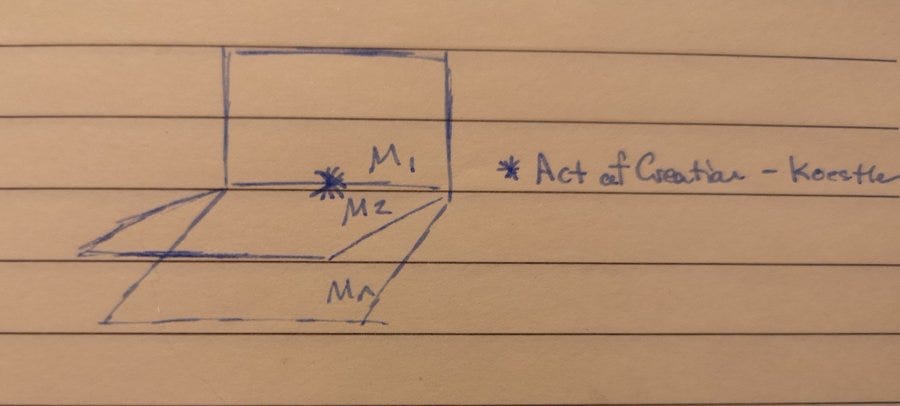Why do people laugh at puns?
Wait - why do people laugh in the first place?
BOTTOM-LINE UP-FRONT: People laugh as a way to release the energy produced when they experience cognitive dissonance. When does a person experience cognitive dissonance? A person experiences cognitive dissonance when they have to consider two seemingly contradictory ideas at the same time. The experience of holding two seemingly contradictory ideas at the same time produces energy, energy which is released by the person the form of laughter.
All acts of creation are generated by the sudden bisociation of previously unrelated matrices of experience.
- Koestler, The Act of Creation
Huh? I’ll explain.
The Difference Between Soccer And Basketball
Here’s a joke: The only difference between soccer and basketball is the currency used to bribe the referees.
Let’s understand why the joke is funny.
All acts of creation are generated by the sudden bisociation of previously unrelated matrices of experience.
- Koestler, The Act of Creation
Soccer is a matrix of experience; some people call a matrix of experience a domain. For the purposes of this conversation we’ll consider a matrix and a domain the same thing.
So soccer is a matrix of experience aka domain. When you go to a soccer match, you expect to see players, two goals, referees, and a ball that the players kick with their feet.
Basketball is a matrix of experience aka domain. When you go to a basketball game, you expect to see players, two nets, referees, and a ball that the players bounce, pass and shoot with their hands.
The only difference between soccer and basketball is the currency used to bribe the referees - that’s the joke.
Soccer is a matrix of experience, and basketball is a matrix of experience.
When we create a connection between these two different sports - the way in which their referees are bribed - the audience has to consider two seemingly contradictory ideas simultaneously. When the audience has to consider the bribes in soccer and the bribes in basketball, the cognitive dissonance produced by trying to consider these two seemingly contradictory ideas at the same time produces energy which is release as laughter.
All acts of creation are generated by the sudden bisociation of previously unrelated matrices of experience.
- Koestler, The Act of Creation
Does this quote make sense now?
OK now let’s consider puns now that you have the right tools.
Why Do Puns Make People Laugh?
Conan O’Brien: What the name of the movie?
Melrose Place Lady: Chairman of the Board.
Norm McDonald: I bet it’s spelled, “B-O-R-E-D”.
Here’s a pun: when Asian poets eat Starburst they call that a Hi-Chew.
Why do people laugh at puns?
People laugh at puns because they create an experience of cognitive dissonance because the audience has to consider two seemingly-contradictory ideas as the same time which create energy that’s released as laughter.
A pun is an effective way to make people laugh because a pun is a word that can operate in two or more matrices of experience aka domains at the same time.
Let’s Practice
Here are some more examples of jokes that generate laughter because they create a situation where the audience has to consider two seemingly contradictory ideas at the same time which produces energy that’s released as laughter.
Q: Can you tell what matrices of experience are being presented simultaneously?
So in review, why do people laugh?
People laugh because they experience cognitive dissonance produced when they are forced to consider two seemingly-contradictory ideas simultaneously which creates energy which is released as laughter.
For more reading, check out Arthur Koestler’s The Act of Creation.
The Backstory
About a decade ago, I got fed up with finance and began doing stand up comedy.
I soon met someone who would become my mentor in comedy - Quinn C. Martin.
Quinn was always focused on WHY people were laughing. It seemed like a simple question back then.
I wanted to know something similar yet different; I wanted to know how to make people laugh. Invariably, I began listening to my favourite comedians to get ideas. But then I ended up just becoming a caricature of them.
Then I read this book called Zen and the Art of Stand-up Comedy. That book taught me the premise-punchline-tag joke structure, rule of threes, and other standard fare tricks of the trade.
But then I came across The Act of Creation by Arthur Koestler, a book mentioned by George Carlin during his last interview. It was 700 pages; I only needed the first 100 to understand something deeper than laughter - creativity itself.
A few other things to consider when communicating.
Persona-Driven Communication
What the learner learns is a function of what they already know.
- Kullback-Leibler Divergence h/t Baez
What someone learns in an interaction is measured by the amount of surprise they experience. People are primarily interested in themselves, so if you’re not talking about them they probably aren’t going to be all that interested in what you have to say.
We ingest content through our metaphor frameworks.
- Dr. Robert Whetsel
The Two People Who Can Make Fun of the King
There are two people who can make fun of the King without losing their head:
The Queen
The Joker.
Consider those three people. The King, The Queen, and The Joker.
Each of these beings express their truth very differently.
The King employs logic, The Queen employs art, and The Joker employs comedy.
Joker (Comedian)
King (Logic)
Queen (Artist)
Similarly, All ideas can be expressed in three ways:
Comical
Logical
Artistic
Academics feel that only logic can hold the truth. Jokers and Comedians specialize in expressing constructs using laughter. Artists and Musicians prefer to hold the truth song and lyric and painting.
Each of these people - the academic, comedian and artist - are all right, and they’re all wrong.
Wisdom is disembodied; Understanding is embodied through use. Techne vs. Episteme; the knowledge of something versus the knowledge of doing something.
This idea of expressing ideas across the comedic, logical and artistic was expressed by Koestler in The Tryptych. The Tryptych depicts how the Joker, Logician and Artist use similar but different tools of inquiry to describe phenomenon.













